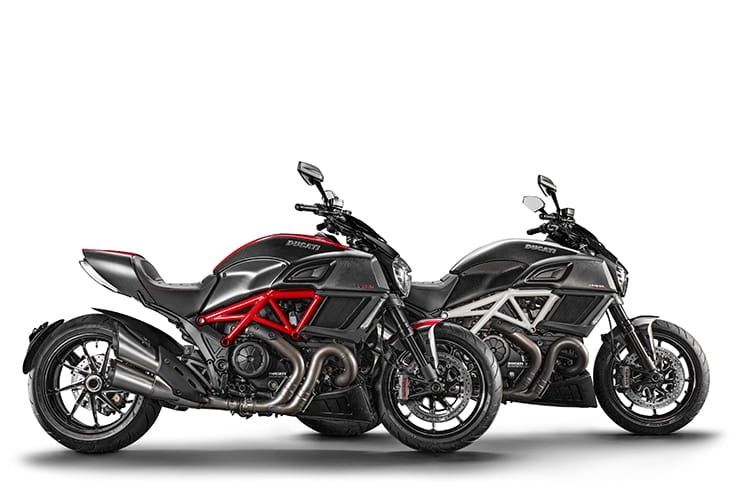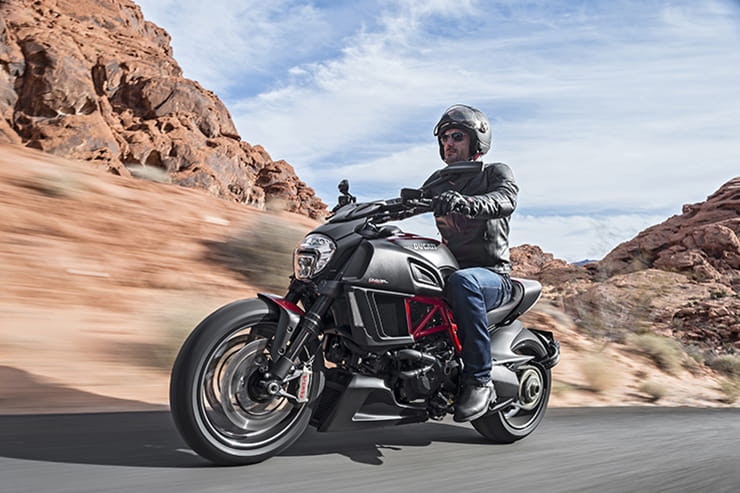Ducati Diavel & Diavel Carbon (2011 - 2017): Review & Buying Guide
By Jon Urry
Massively experienced road tester
07.05.2021
When Ducati announced in 2011 that they were about to launch a performance cruiser, most rider’s instant reaction was confusion. What on earth were Ducati doing entering the cruiser market? Would we start to see a whole range of Ducati models with leather seats, tassels and saddle bags? That’s not what the Bologna manufacturer was known, or respected, for building! Well, as is so often the way the clue is in the name and when the Diavel arrived (which is the Bolognese dialect word for Devil) it was most certainly a performance cruiser with the emphasis firmly on the performance rather than the cruising side. Amazing looking and packing a seriously impressive 162bhp alongside a full electronics package, the Diavel won over loads of doubters and has gone on to be one of the firm’s most recognisable, if not possibly best-selling, models. If you like the idea of a head-turning naked bike that is a bit more relaxed than a full-on super naked, the Diavel could be your cup of tea. Or should that be goblet of blood...
Ducati Diavel & Diavel Carbon (2011 - 2017) Price
The Diavel is far from a cheap bike. This is no basic air-cooled cruiser, it is a full-on Ducati product with a high spec list and its price tag reflects this. Brand new the base Diavel was £12,995 where the higher-spec (in terms of bolt-ons) Carbon was £15,895. Nowadays this translates to you having to shell out roughly £7000 in a private sale or £7500 from a dealer for a base model and £8000-8500 for a Carbon. The updated 2015 model, which again came in stock or Carbon versions, is closer to £10,000 for the stock or £11,750 for a Carbon. Prices for the various ‘special editions’ such as the Titanium, AMG, Strada or Diesel vary depending on the exclusivity of the bike. Well, it’s a Ducati...
Power and torque
You just have to love the fact that Ducati didn’t pull any punches and stuck the Testastretta 11-degree engine straight into their cruiser model. With 162bhp on tap backed up by a thumping 94lb-ft of torque, it is hardly left lacking in any department and is quite simply hysterical to ride. Ridiculously fast yet also brimming with character, the engine may have started life in the 1098 sportsbike but it is fairly well suited to being used in a performance cruiser and can be surprisingly lazy if requested. Like all V-twins it can get a bit stuttery when the revs drop very low, but once on the go it is a brilliant motor. And it sounds amazing through a set of loud pipes!
Engine, gearbox and exhaust
The Testastretta motor is a really solid unit and when buying used you only need to worry about service history, which on the Diavel isn’t too horrible thanks to an extended service schedule. When it was launched Ducati announced that new valve technology had allowed them to extend the costly ‘desmo’ valve-clearance check service and belt swap to 15,000 miles/five years (18,000 miles on the 2015-omwards model), which is far more wallet-friendly as it costs around £800 to get completed! The Diavel still needs an annual service but as this is just oil and filters it is less than £200, so isn’t horrific. The gearbox is solid and aside from the occasional fuel sensor issue, you can buy a Diavel with a high degree of confidence. In terms of the exhaust, as you would expect on a Ducati most Diavels have some sort of aftermarket pipe on them with Termi the most sought-after but also expensive option and cheaper brands less desirable. If a pipe is fitted, it is always best to have a high flow air filter and the ECU remapped to get the most from the freer flowing pipe and release a bit of extra grunt. In 2015 the Diavel gained the new ‘twin spark’ motor alongside a few small styling updates. Power was slightly increased to 162bhp with the torque up to 96.2lb-ft, which isn’t really noticeable.
Ducati Diavel & Diavel Carbon (2011 - 2017) Economy
You can expect to record 40-45mpg fairly easy on the Diavel with a tank range approaching the 150-mile mark if you take it fairly easy. Up the pace, however, and this plummets to mid 30s mpg and that means you will see the fuel warning light at just 90 miles...
Handling, suspension, chassis and weight
First of all we have to talk about that rear wheel, which is one of the Diavel’s stand-out points. An enormous 240-section, it looks like it should ruin the Ducati’s agility but actually the Diavel is a really sweet handing bike that while not quite super naked in its turning isn’t that far off! Thanks to a sporty trellis frame, chunky inverted forks and 17-inch wheels, the Diavel is a bike that (ground clearance allowing...) can be thoroughly enjoyed in the bends – which is a real surprise to those who have never ridden one before. The Carbon has slightly higher-spec forks but in truth the DLC coating is only a visual enhancement and on the road you won’t spot any benefit over the stock bike’s units. What you will notice, however, is the forged Marchesini wheels, which do make it turn a bit sweeter as they are 2.5kg lighter than the cast items the stock bike is shod in. While new you would struggle to justify the price difference between the two versions, in the used market the gap is considerably lower so if you can stretch to another £1000, buying the Carbon is worth doing if possible. Speaking of buying used, the chassis is the one area you do need to be slightly careful of when looking at a Diavel. Owners report that the keyless ignition has a habit of losing contact with the bike, the TFT dash is known to mist up and there have been two recalls on the Diavel, one in 2014 for the number plate assembly potentially working loose and one in 2012 for cracking sidestands. It is highly unlikely any bike won't have had these completed, but always check to be on the safe side and also inspect the single sided swingarm’s hub for damage.
Ducati Diavel & Diavel Carbon (2011 - 2017) Brakes
With ABS and twin Brembo monoblock calipers the Diavel has some serious stopping power. The fact it is a long and low cruiser can push the front a bit if you brake hard, so you are advised to also use the rear rake, but you can’t really wish for more. It’s a small detail, but the Carbon get slightly flasher discs, which feature milled carriers and weight-saving cut-outs. Nice...
Comfort over distance and touring
Hmm, yeah, not the best. The Diavel isn’t a very comfortable bike for a rider and fairly horrible for a pillion. This is a city cruiser and despite the fact Ducati launched the Strada in 2012 with panniers and a pillion backrest, it didn’t stay very long in the model range, which tells you everything you need to know. Keep it for sunny days rides – solo!
Rider aids and extra equipment / accessories
Considering the Diavel came out in 2011 the fact you get three power modes (Sport, Touring, Urban) a twin TFT dash (which was updated in 2015), keyless ignition, ABS and even TC is quite impressive. While not angle-sensitive, all the safety assists are reasonably effective in their operation and that’s all you can ask of them. There are a few issues to be wary of (the TFT dash misting and the keyless ignition getting confused) but generally the electrics are solid. In terms of accessories, loads of owners fit an aftermarket exhaust end can, a few go for screens, there is the occasional tail tidy and a back rest to appease unhappy pillions but not that many Diavels get too accessorised. Ideally you want one with Termi pipes, an ECU remap or fuelling module fitted and not much else aside from a new clutch slave cylinder to make its action a bit lighter. If you like carbon bling, get the Carbon as it is cheaper to buy one than spend the cash on bolt-ons pimping-up a stock Diavel.
Ducati Diavel & Diavel Carbon (2011 - 2017) verdict
The Diavel won’t appeal to everyone, which is understandable as it is quite a unique bike, but those who do like the idea of a Ducati-built performance cruiser won’t feel let down by it. Fast, good handling and a real head-turner, the Diavel is a bike that delivers on its promise. Unless, of course, you think it is promising to be comfortable!
Three things we love about the Diavel…
Amazing looks
Surprising performance
Impressive handling
Three things that we don’t…
High price tag
Ground clearance issues
Poor comfort levels
Ducati Diavel & Diavel Carbon (2011 - 2017) spec
Looking for motorcycle insurance? Get a quote for this motorbike with Bennetts bike insurance


